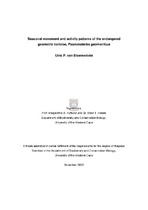Seasonal movement and activity patterns of the endangered geometric tortoise, psammobates geometricus
Abstract
Due to the critical status of Psammobates geometricus and the vulnerability of their habitat, there is a need to allocate areas for their protection. The aim of this study was to provide information on the space requirements and activity level of geometric tortoises to facilitate future conservation efforts. The thread-and-spool method was used to compare short-term movements, habitat utilisation, and activity patterns of male and female tortoises over 15 and 20 days respectively, in autumn and spring. Through radiotelemetry, the long-term movements of 10 male and 11 female tortoises were evaluated from April 2002 to April 2003. Locality data for the short-term and long-term studies were used to calculate the size of activity areas and home ranges as minimum convex polygons and fixed kernel estimates. Male and female geometric tortoises were active throughout the year, and maintained a high level of activity in autumn and in spring. However, females were more active than males were in spring. Females may require more resources, particularly food, in spring when they produce eggs. Although males and females travelled similar distances in autumn and in spring, males displaced further than females displaced in both seasons. The movement path for males was often linear, perhaps because this path may enhance their opportunities to encounter females. Geometric tortoise males were substantially smaller than females, which may explain why the distances that males moved and displaced in spring were negatively correlated to environmental temperature. In autumn, when temperatures were lower than in spring, the distance travelled by males was not correlated to temperature. However, in autumn female displacement showed a positive correlation with environmental temperature. Geometric tortoises showed large inter-individual variation in home range size, which may contribute to the fact that home range size did not differ among the three different habitat types: mature renosterveld, burned renosterveld and the old agricultural fields. Average home range size was 11.5 ha for 95% fixed kernel estimates, and 7.0 ha for minimum convex polygon estimates. Body size influenced the home range size of female geometric tortoises, but had no effect on the home range size of male tortoises. Females had larger home ranges than male tortoises had, possibly because females were larger, but reproductive requirements of females may have played a role. During the dry season, home range size increased when compared to the wet season. The larger home range during the dry season, which is associated with high temperatures, may be related to a reduction in resource availability. The fewer resources available, the greater the distance the tortoises would need to travel in order to acquire the necessary resources. The small home range in the wet season may indicate an abundance of resources, but it may also be that large pools of standing water restrict the movements of tortoises.
Understanding the spatial and habitat requirements of P. geometricus will help to assess the viability of populations in disturbed and highly fragmented areas, and contribute to the conservation efforts for this endangered species.

